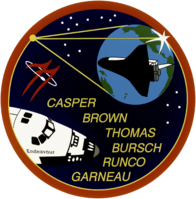STS-77
 | |
| Dane misji | |
| Indeks COSPAR | 1996-032A |
|---|---|
| Zaangażowani | |
| Oznaczenie kodowe | STS-77 |
| Pojazd | |
| Wahadłowiec | |
| Załoga | |
 Siedzą od lewej: Curtis Brown, John Casper. Stoją od lewej: Daniel Bursch, Mario Runco, Marc Garneau, Andrew Thomas. | |
| Dowódca | |
| Start | |
| Miejsce startu | |
| Początek misji | |
| Orbita okołoziemska | |
| Apogeum | 287 km |
| Perygeum | 278 km |
| Okres orbitalny | 90,1 min |
| Inklinacja orbity | 39,0° |
| Lądowanie | |
| Miejsce lądowania | KSC, Pas startowy 33 |
| Lądowanie | 29 maja 1996 11:09:18 UTC[1] |
| Czas trwania misji | 10 dni, 0 godz, 39 min, 18 sek[1] |
| Przebyta odległość | 6 598 310 km[1] |
| Liczba okrążeń Ziemi | 161[1] |
| Program lotów wahadłowców | |
STS-77 (ang. Space Transportation System) – jedenasta, dziesięciodniowa misja amerykańskiego wahadłowca Endeavour i siedemdziesiąta siódma programu lotów wahadłowców[2].
Załoga
- John Casper (4)* – dowódca
- Curtis Brown (3) – pilot
- Daniel Bursch (3) – specjalista misji 2
- Mario Runco (3) – specjalista misji 3
- Marc Garneau (2) – specjalista misji 4 (CSA, Kanada)
- Andy Thomas (1) – specjalista misji 1
- *(liczba w nawiasie oznacza liczbę lotów odbytych przez każdego z astronautów)
Parametry misji
- Masa:
- Perygeum: 278 km[4]
- Apogeum: 287 km[4]
- Inklinacja: 39,0°[4]
- Okres orbitalny: 90,1 min[4]
Cel misji
Lot z laboratorium Spacehab-LSM oraz umieszczenie na orbicie, a następnie przechwycenie satelity Spartan-207. Satelita Spartan (Shuttle Pointed Autonomous Research Tool for Astronomy) rozłożył na orbicie nadmuchiwaną antenę paraboliczną. Do umieszczenia satelity na orbicie wystarczał manipulator promu, a spacer kosmiczny nie był konieczny[5].
Zobacz też
Przypisy
- ↑ a b c d e f g h Mark Wade: STS-77. [w:] Encyclopedia Astronautica [on-line]. [dostęp 2017-07-25]. (ang.).
- ↑ a b c Tomáš Přibyl: Dzień, w którym nie wróciła COLUMBIA. Debit, czerwiec 2003. ISBN 83-7167-224-1.
- ↑ Robert Godwin: Space Shuttle. Warszawa: Prószyński Media Sp. z o.o., 2011, s. 75, seria: Historia podboju Kosmosu. ISBN 978-83-7648-973-5.
- ↑ a b c d STS 77. [w:] NSSDCA Master Catalog [on-line]. NASA. [dostęp 2014-06-14]. [zarchiwizowane z tego adresu (2014-07-14)]. (ang.).
- ↑ a b Misje free-flyer. T. 108. Poznań: Amermedia Sp. z o.o., 2014, s. 21, seria: Kosmos. Tajemnice Wszechświata. Encyklopedia Astronomii i Astronautyki. ISBN 978-83-252-2324-3.
Linki zewnętrzne
- podsumowanie misji STS-77 na stronie KSC (ang.)
- Mark Wade: STS-77. [w:] Encyclopedia Astronautica [on-line]. [dostęp 2017-07-25]. (ang.).
- Spaceflight mission report: STS-77. Spacefacts. [dostęp 2017-07-25]. (ang.).
Media użyte na tej stronie
The flag of Navassa Island is simply the United States flag. It does not have a "local" flag or "unofficial" flag; it is an uninhabited island. The version with a profile view was based on Flags of the World and as a fictional design has no status warranting a place on any Wiki. It was made up by a random person with no connection to the island, it has never flown on the island, and it has never received any sort of recognition or validation by any authority. The person quoted on that page has no authority to bestow a flag, "unofficial" or otherwise, on the island.
The crew assigned to the STS-77 mission included (seated left to right) Curtis L. Brown, pilot; and John H. Casper, commander. Standing, left to right, are mission specialists Daniel W. Bursch, Mario Runco, Marc Garneau (CSA), and Andrew S. W. Thomas. Launched aboard the Space Shuttle Endeavour on May 19, 1996 at 6:30:00 am (EDT), the STS-77 mission carried three primary payloads; the SPACEHAB-4 pressurized research module, the Inflatable Antenna Experiment (IAE) mounted on a Spartan 207 free-flyer, and a suite of four technology demonstration experiments known as Technology Experiments for Advancing Missions in Space (TEAMS).
The STS-77 crew patch displays the Shuttle Endeavour in the lower left and its reflection within the tripod and concave parabolic mirror of the SPARTAN Inflatable Antenna Experiment (IAE). The center leg of the tripod also delineates the top of the Spacehab's shape, the rest of which is outlined in gold just inside the red perimeter. The Spacehab was carried in the payload bay and housed the Commercial Float Zone Furnace (CFZF). Also depicted within the confines of the IAE mirror are the mission's rendezvous operations with the Passive Aerodynamically-Stabilized Magnetically-Damped satellite (PAM/STU) appears as a bright six-pointed star-like reflection of the sun on the edge of the mirror with Endeavour in position to track it. The sunlight on the mirror's edge, which also appears as an orbital sunset, is located over Goddard Space Flight Center, the development facility for the SPARTAN/IAE and Technology Experiments Advancing Missions in Space (TEAMS) experiments. The reflection of the Earth is oriented to show the individual countries of the crew as well as the ocean which Captain Cook explored in the original Endeavour. The mission number 77 is featured as twin stylized chevrons and an orbiting satellite as adapted from NASA's logo. The stars at the top are arranged as seen in the northern sky in the vicinity of the constellation Ursa Minor. The field of 11 stars represents both the TEAMS cluster of experiments (the four antennae of GPS Attitude and Navigation Experiment (GANE), the single canister of Liquid Metal Thermal Experiment (LMTE), the three canisters of Vented Tank Resupply Experiment (VTRE), and the three canisters of PAM/STU) and the 11th flight of Endeavour. The constellation at the right shows the fourth flight of Spacehab Experiments.


